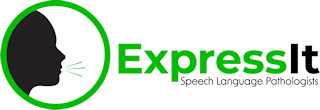Speech Therapy: Speech therapy provides therapeutic interventions to individuals who have difficulty producing the sounds needed to produce intelligible words and connected speech. Before someone can receive speech therapy, they require a comprehensive evaluation of their speech sound production and the function of their speech motor mechanism. A comprehensive evaluation allows the speech and language pathologist to determine not just the sounds a person is having difficulty producing, but also the etiology of their production problems. Once a speech evaluation is completed, the speech and language pathologist can create an intervention plan that will effectively improve an individual’s specific speech production difficulties.
Language Therapy: Language therapy provides therapeutic interventions to individuals who have difficulties with their receptive and/or expressive language abilities. Language therapy focuses on the underlying language concepts that are necessary for an individual to understand and use language to communicate within their daily lives. Language therapy is individually planned for a person’s specific language impairment needs.
Feeding Therapy: Feeding therapy focuses on improving a person’s ability to eat and drink independently. Feeding therapy is necessary if there is a problem with one of the four stages of swallowing. The first three phases are voluntary as the food or liquid is prepared in the oral cavity into a bolus (oral preparatory phase), then in the second stage the bolus is propelled by the tongue (oral transit) to initiate the pharyngeal phase of the swallow where the bolus is propelled through the pharynx. The final stage of the swallow is involuntary as the bolus is carried to the stomach (esophageal phase). The oral preparatory phase of the swallow involves how a person bites, chews and gets the food ready. The oral transit phase of the swallow involves the movements of the tongue to move the food from the oral cavity toward the esophagus. The pharyngeal phase of the swallow is the transition phase from the oral cavity to the esophagus.Individuals from birth through the lifespan can experience difficulties with any phase of the swallow.
Many professionals refer to feeding problems as behavioral, sensory, or motor-based. To determine the appropriate diagnosis and treatment plan for an individual seeking feeding therapy, a thorough evaluation should be conducted and should include an evaluation of oral motor mechanism, observation of biting, chewing, and swallowing (in an infant it would be bottle or breast feeding), a diet profile, medical history review (growth chart, medical records, past interventions), and a parent interview. A thorough feeding evaluation that identifies the specific motor, sensory, and/or behavioral factors that are impeding an individual’s ability to eat or drink prior to initiating feeding therapy allows for planning a successful plan for therapeutic intervention. A successful feeding therapy intervention plan may include a referral to a GI, ENT, or nutritional professional.
Pre/post Frenectomy Evaluation and treatment: A frenectomy is a surgical procedure that involves removing or releasing the frenum, a small band of tissue that connects the upper and lower lips, the tongue, or the gums to the jawbone. This procedure is often performed to improve oral function and address problems such as difficulty chewing and swallowing, poor oral resting posture, sleep problems, and/or difficulty with speech production.
There are two main types of frenectomy: surgical and laser. A surgical frenectomy involves making an incision in the gum tissue to access the frenum and removing it with a scalpel or other surgical instrument. This procedure requires local anesthesia and may result in some bleeding and discomfort.
A laser frenectomy, on the other hand, involves using a laser to remove the frenum. This procedure is less invasive and typically results in less bleeding and discomfort. However, laser frenectomy may not be suitable for all patients, as the laser may not be able to remove the entire frenum in some cases.
Before an individual receives a frenectomy, they should have a full functional evaluation by a speech and language pathologist of their oral motor mechanism to determine how the frenectomy is impacting the use of the muscles and body parts or the oral motor mechanism. If there are functional limitations of the oral motor mechanism, the speech and language pathologist can create a pre- and post-procedure therapeutic plan. This plan will include improving the function of the muscles and body parts that have been functioning improperly due to the restrictions of movement caused the frenum that will be surgically removed or released. The oral motor mechanism will not function properly after a frenectomy of the individual does not learn proper motor plans for normal functioning.
Myofunctional Therapy: Myofunctional therapy is a form of treatment provided by a speech and language pathologist that focuses on improving the function of the muscles in the mouth, face, and throat. This therapy may be recommended for individuals with improper function of the tongue for speech, swallowing, and normal oral resting posture.
During myofunctional therapy, the speech and language pathologist will work with the patient to perform a series of exercises that target specific muscles in the mouth, face, and throat. These exercises may include tongue exercises, lip exercises, and facial muscle exercises. The therapist may also teach the patient proper oral resting posture and breathing techniques to improve their overall oral function. (add myofunctional therapy is for children aged 5 and up or individuals that can follow directions and complete exercises independently or with parental assistance)
Myofunctional therapy requires voluntary control of the muscles of the mouth and face which requires that an individual can follow complex directions. It is not advised to engage in Myofunctional therapy in children younger than 5. If your child has any issues with the muscles of their mouth or face that is impacting their swallow, they should be referred for a feeding evaluation.
